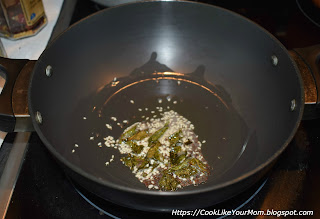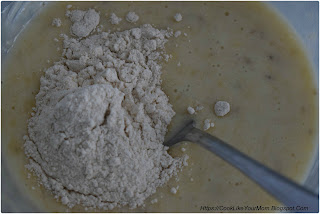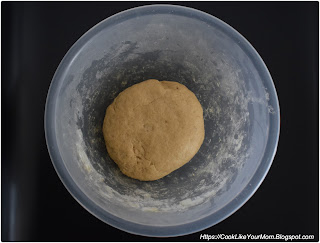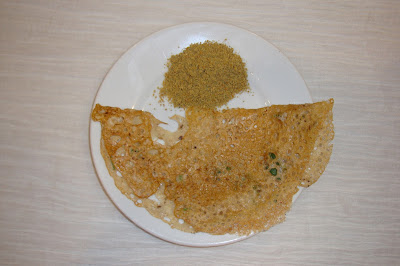After a long gap I finally found some time to publish...
Rava Dhokla is a steamed delicacy from Gujarat. This is usually served hot with "Pudina Chutney"(Spicy mint dip) or "Methino Masala" (Coarsely ground spicy fenugreek powder).
This dish can be served for breakfast, starter for a lunch or dinner, or as snack by itself. Its fluffy, spongy and also filling :)
The version explained here is a basic one, however variations can be made by adding vegetables like carrot, peas, finely chopped beans to it. A person from south of India can easily relate to this as it tastes little bit like Rava Idli.
This traditional recipe was shared by my very good friend Darshana, who hails from Gujarat. I thank her for the recipe and helping me with the dish and also sharing the nuances !! I had kept this recipe in draft for many weeks, as I couldn't find time to put things together. As today is Darshana's wedding anniversary, I couldn't find a better occasion to wrap up and publish this amazing recipe.
Ingredients :
(For making close to 20+ pieces)
For the Dhokla
Fine Rava / Semolina : 1 cup (240ml)
Curd (Sour live set preferable) : 1 cup
Ginger : 1/2 inch
Green chillies : 2 to 3 (as per taste)
Fruit salt : 1 Tspoon(~5 ml) (I used plain Eno)
Cooking oil : 2 Tspoons
Water : 1/4 cup (Approx)
Salt : as per taste
For Seasoning
Mustard seeds : 1/2 Tspoon
Sesame seeds (White preffered) : 1/2 Tspoon
Curry/Coriander leave : 1 sprig
Grated coconut : 1 Tspoon
Asafoetida (Heeng/Perungayam) : One pinch
Cooking oil : 1 Tspoon
Procedure
Dhokla
- Coarse grind green chilli and ginger.
- Take a broad vessel, add semolina(rava), curd, chilli-ginger paste and salt. Mix it well. Check for the consistency. It should be spoonable, but not flowy. When you take a spoonful of batter and pour it, it shouldn't fall smoothly, but with breaks. If the consistency isn't achieved and if the batter is too thick, add little water and mix well.
- Keep the batter aside for 15 to 20 mins.
- In the mean time grease a wide plate, set a steamer, and keep the greased plate in it and switch on the steamer. This will help pre-heat the steamer.
- After 15 to 20 mins, check the batter. As semolina/rava soaks moisture, the batter would have become thick. Add water little by little till spoonable consistency.
- Add oil to the batter. Mix well.
- Add the fruit salt and mix well. The batter will foam little bit due to the fuit salt which was added.
 |
| Fruit salt is added and stirred well. Foaming can be seen in the above pic. |
- Shake the plate to spread the batter evenly.
- Close the steamer and allow it to steam in high for 5 mins.
- Bring the stove to medium and steam for 15 more mins.
- See to it that the steamer has enough water. If the water level reduces, pour boiling water carefully into the steamer. Care is to be taken that it doesn't spill on the Dhokla
- After 20 full minutes, check if the dhokla is cooked. Poke a toothpick or a fork and check if it comes out clean.
- If its cooked, then switch off the stove, and keep the dhokla aside for cooling.
- Cut the dhokla into small pieces.
Tempering
- Take a pan, heat oil, add mustard seeds.
- Once mustard seeds crackle, add sesame seeds and roast it. Add curry leaves and asafoetida.
- Bring the tempering out of the flame. Coat the Dhokla with this tempering.
- Sprinkle grated coconut, chopped coriander (if any) on top of the Dhokla.
Serving
- Serve the hot Dhoklas with mint chutney, methiya masala.
Variations
- Add vegetables like grated carrot, peas, finely sliced beans to the batter for vegetable Dhokla. Care should be taken while checking the consistency as carrot tends to leave water. If desired the vegetables can be sauteed before adding it to the batter.
- You can replace Fruit Salt by Cooking soda (Soda Bicarb). 1 spoon of Fruit salt can be replaced by 1/4 Cooking soda. (I haven't tried this version though).
Tips
- Consistency of the batter should be spoonable. It shouldn't fall freely when you drop it with a spoon. The batter should be little firmer than Rava Idli batter.
- Pre-heating of the steamer and keeping it ready is essential. This will help the Fruit salt to do its work and help raise the Dhokla well.
- Check the level of water before preparing the steamer.
- While the water level gets too low in the steamer, add hot water only. The Dhokla needs constant steam for it to cook well.
- Try not to open the steamer for the first 15 minutes at least. Opening the steamer will bring down the cooking temperature and it will affect the fluffiness of the dish.
- Colour of the Dhokla depends on the colour of the semolina/rava used. My semolina was cream in colour hence my Dhokla too.


































